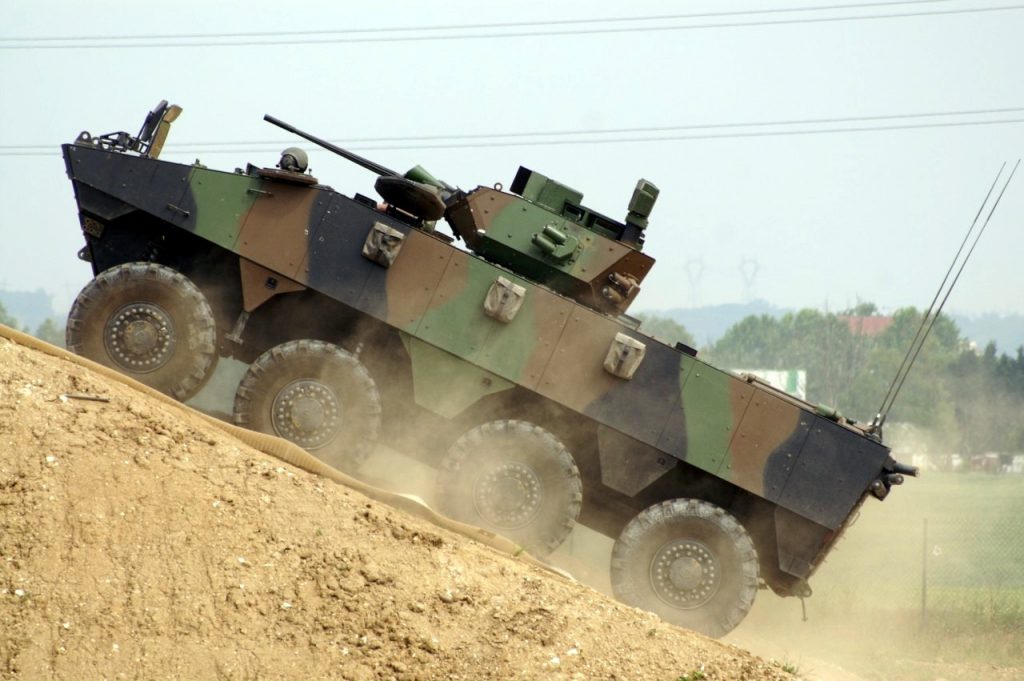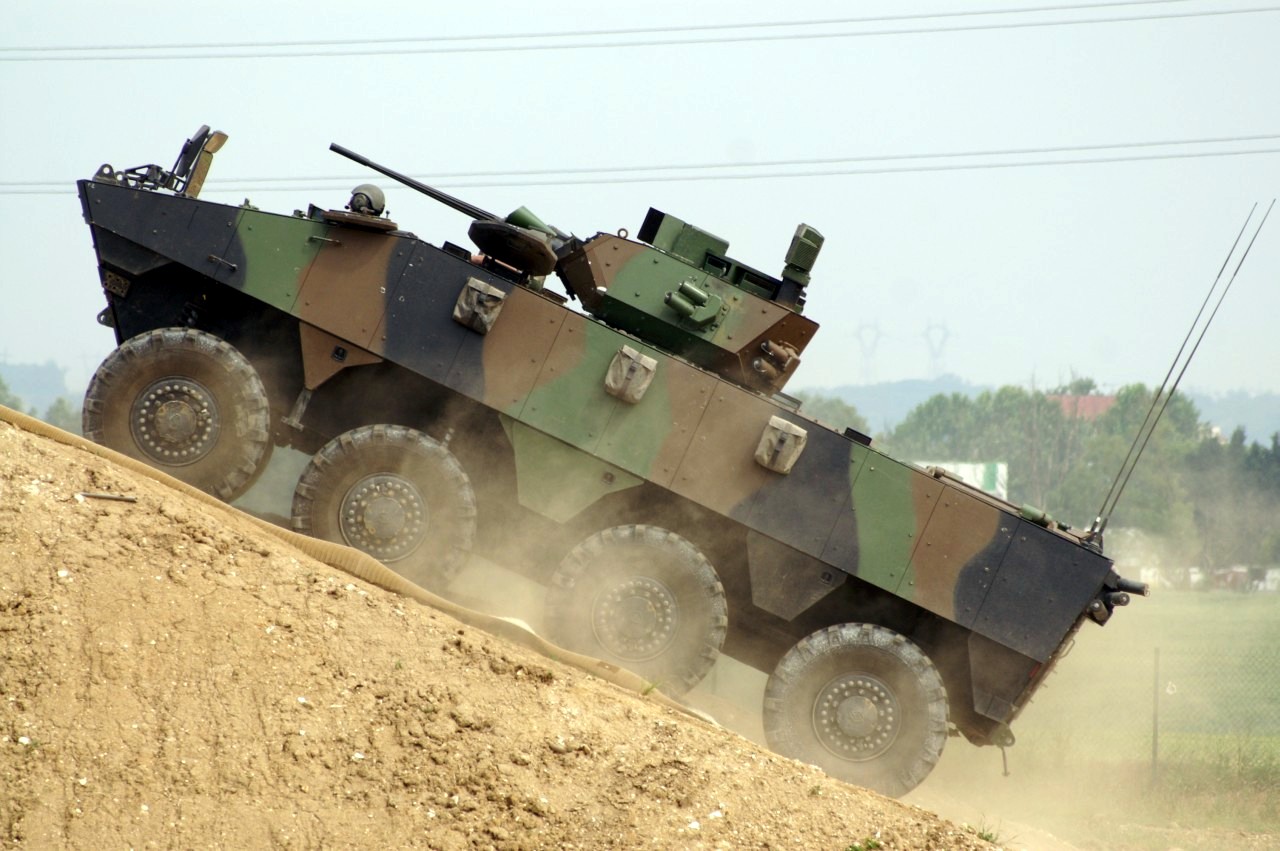
The VBCI protects an entire infantry section during high-intensity combat missions as well as peacekeeping missions. VCBI has been “Combat Proven” and is currently in use. VBCI provides the best balance of protection, firepower, mobility, and payload. VBCI has unparalleled overall survivability, including ballistic, mine, and IED protection, as well as “Soft Kill” systems. It is outfitted with CBRN technology.
The VBCI (French for “Véhicule Blindé de Combat d’Infanterie)” is a French wheeled armoured infantry fighting vehicle designed and manufactured by Nexter Systems and Renault Trucks Defense. The VBCI was designed to replace the French Army’s old tracked armoured infantry fighting vehicle AMX-10P, which was used by infantry mechanised units. The French Ministry of Defense awarded the first 65 vehicles to Giat Industries and Renault VI (now Renault Trucks) in November 2000. (54 VCI – including 12 with the Eryx missile system – and 11 VPC). Giat and Renault Trucks formed a joint venture company called Satory Military Vehicles to handle the VBCI and other vehicles.
Renault is in charge of the mobility systems, which include the driver’s station, engine, transmission, suspension and axles, and on-board electrical networks. Giat is in charge of the armoured hull, interior furnishing, turret and vehicle assembly and integration, observation, command and control, weapons, and self-protection systems.
In May 2004, the first two prototypes were completed. Five prototypes, four VCI and one VPC, have been delivered and are undergoing qualification trials. One is undergoing operational training with the French Army. Serial production is underway, with the first three production vehicles, two IFVs and one command variant, delivered in May 2008.
The DGA granted qualification in March 2008, and the VBCI is now in series production. The DGA placed a supplemental order for 116 vehicles with Nexter Systems and Renault Trucks Defense on December 5, 2008. This order brings the total number of vehicles ordered to 298 VBCIs to date.
According to the initial schedule, the DGA has accepted the first 49 vehicles. In September 2009, Hervé Morin, Minister of Defence, announced an order for 332 VBCI armoured infantry combat vehicles for the Army. The Délégation générale pour l’armement (DGA) awarded the contract to a joint venture company owned by Nexter Systems and Renault Trucks Defense.
This latest order brings the Army’s total number of VBCIs on order to 630, as specified in the White Paper on defence and national security. The VBCI program’s total cost, including development and pre-production, is 2.86 billion euros. (approximately $4.1 billion).
A hundred vehicles are produced annually for France, but the assembly line could produce at a much higher rate to meet any potential export requirements. Because of the VBCI’s basic simplicity, the production line could also be transferred in the event of export contracts involving local provisioning, production, and/or integration.
GTD and Nexter Systems signed a shareholder agreement in December 2009, establishing a Spanish joint venture in the coming weeks. One of the new company’s primary responsibilities will be to fulfil the contract for the Spanish “Vehiculo Blindado Ruedas 8×8” (VBR 8×8) programme, which will replace the existing BMR vehicle.
Variants:
– VPC: (command post vehicle) is outfitted with a Nexter Systems FINDERS® terminal information system (SIT), an EADS regimental information system (SIR), and a remotely controlled 12.7 mm cupola. The French Army has placed an order for 150 VPCs.
– VBCI: (infantry fighting vehicle) with a 20mm RWS, 25mm, 30mm, or 40mm medium-caliber turret and a 7.62mm MG. The rank VBCI is also available in mortar and Eryx (short-range, anti-tank missile system) variants, and can be outfitted with 25 to 105 mm turrets or a 120 mm low-recoil cannon. The French Army has ordered 550 “rank” version VCIs.
– VTT: (Troop Transport Vehicle) A troop transport vehicle. It has a 13-m3 interior volume and can transport a two-man crew as well as up to ten soldiers and their equipment. The VTT is designed to meet export requirements and is being considered by a number of national armies.
– Based on the same platform, other utility vehicles such as ambulances and repair vehicles can be produced. Mine clearance, for example. The total cost of possession is reduced by using a single platform shared by all variants.
Armor
The hull and turret of the VBCI Nexter Systems are made of welded steel and aluminium, providing resistance to small arms fire and artillery shell splinters. The welded steel and aluminium alloy hull is outfitted with spall liners and an add-on titanium armour plate to protect against anti-tank weapons. The floor of the box structure and the running gear protect against exploding mines.
With its high strength alloy hull and add-on metal armour, the VBCI outperforms all existing 8×8 vehicles in terms of protection. The VBCI provides a very high level of structural protection against conventional munitions (medium calibre fire, shell shrapnel). It is also built to withstand improvised explosive devices (IEDs) and powerful mines, and it includes an infrared decoy system.
Finally, because of the significant weight increase, the VBCI protection remains upgradeable and will soon be supplemented by active protection against rockets (type RPG), HE shells, and anti-tank missiles. The VBCI has a crew of three including the driver, commander, gunner and can accommodate 8 infantrymen at the rear of the vehicle. The driver sits in the front of the vehicle on the left side, while the vehicle commander, who dismounts with the troops, sits to the driver’s immediate rear.
The one-mane turret is mounted in the centre of the roof hull, while the power pack compartment is located in the front right and is separated from the rest of the hull. The troop compartment is located in the back, with troops seated on either side facing inwards. They enter and exit the VBCI via a large power-operated ramp in the hull’s rear that opens downwards and has an emergency door on the left side.
Power
The VBCI Nexter Systems is powered by a 550hp diesel engine with an in-line six-cylinder configuration and an automatic gearbox, which is located in the vehicle’s front right corner. Four central axles are protected by armoured housings in an in-line transmission. The VBCI is an 8×8 configuration that deviates from the tracklaying Infantry Combat Vehicle tradition by combining maximum ballistic and anti-mine protection with very high mobility. The VBCI has a range of 470 miles (750 kilometres) and a top speed of 60 miles per hour (100 kilometres per hour). If a wheel is destroyed by a mine explosion, the vehicle can be driven with seven wheels.
Accessories
The commander and gunner on the VBCI Nexter Systems have access to night/day vision capabilities . The commander of the vehicle can quickly access a remote display from the gunner’s sight which includes an override control suite allowing him to operate the turret and weapons. The vehicle is road and rail gauge compatible, and it can be flown on an Airbus A400M. The Nexter Systems VBCI can cross a ford in 1.20 m of water without preparation and 1.50 m of water with preparation.
Operational Capabilities
The VBCI Nexter Systems (Armoured Infantry Combat Vehicle) continues to remain, at the center of land mobile force action doctrines due to its high level of protection, mobility, and built-in modularity. Going by feedback from the current theatres of war, the missions armed forces have become more even more diverse, with an increase in focus on targeted environment control actions that are reversible and limited in their use of force, but can be significantly reinforced if necessary.
To this end, The VBCI is a fully developed product produced by a group of companies led by Nexter Systems and Renault Trucks Defense that meets these operational requirements in terms of strategic, operational, and tactical mobility, as well as protection and configuration changes to meet the needs of various mission types.
The VBCI is combat proven and has seen a wide range of missions abroad, ranging from peacekeeping operations in Lebanon and in the Central African Republic to counter-insurgency missions in Afghanistan; it has also been deployed in conventional combat operations such as those in Mali; all of these are testament to VBCI’s operational versatility and the efficiency of its 25mm weapon system.
VBCI’s ability to operate in a wide range of terrain and extreme weather conditions was demonstrated further during a series of operations, most notably in desert conditions, covering more than 4200km at 50°C without failure.





